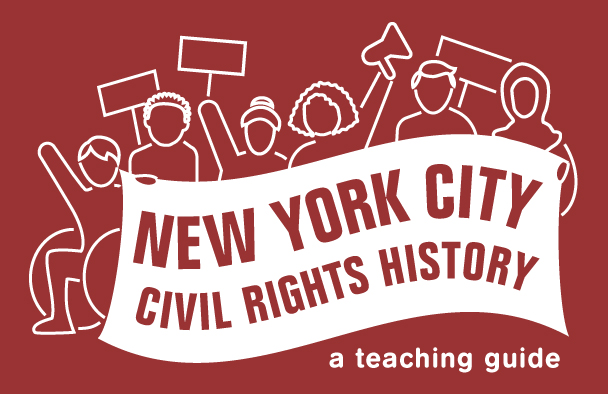- Disabled people and their parents (and those in solidarity with them) have led many struggles for educational justice in New York City. They have done so through a range of strategies and toward a range of goals and visions for education, including survival, citizenship, inclusion, and self-determination.
Disabled students, parents, and advocates always fought for access to education. They did so long before the educational rights of Disabled children were recognized by law. Their efforts included parents creating their own schools, developing organizations, protesting inhumane treatment in state institutions, fighting for public school programs to serve their children’s needs, and bringing court cases.1 Disabled students also organized campaigns for access to buildings, communication, and information they needed to learn.2 They made spaces for their own learning, joy, and connection, as well.3
Some of the first schools in NYC for students with disabilities were those for the Deaf (1817) or blind (1832). These opened when public schooling for white non-disabled students was expanding rapidly across the city. These schools were funded mainly through philanthropy and tuition paid by families. Educators developed specific techniques helpful in educating both Deaf and blind students. But other teaching techniques harmed Disabled students, such as pushing for a certain raised point type (which was more difficult for blind students to read than braille), and forcing oralism onto Deaf students—a method that rejected sign language in favor of learning language only through lip-reading and verbal speech. The first school for “idiots,” a term that at the time likely included people with a variety of disabilities, was founded in 1866. It was located on Randall’s Island, and was funded through a mix of state funding and private tuition.4
Starting in 1884, New York State passed “compulsory education” laws requiring more students to attend school, and for more years. However, schools could still legally reject students with certain disabilities until 1975.5 Some parents and advocates fought this exclusion by starting their own schools and programs, while lobbying state and federal government for access to a free public education for their children.
While Disabled people and their allies had worked to expand education in a variety of ways for over a century, disability rights activism grew significantly during the 1960s and thereafter. The civil rights movement of Black Americans inspired other groups with a shared identity—such as women, queer people, and Disabled people —to forge their own.6 Disabled people fought for recognition that disability was an integral part of human diversity. Moreover, they sought legal recognition of their rights and acknowledgment of discrimination faced in a range of venues, including employment, housing, transportation, and education.7 Their activism helped bring about the first federal legislation for disability rights within education - the “Education for All Handicapped Children Act’’ of 1975, later renamed the Individuals with Disabilities Education Act.8 Activists called attention to how physical spaces, communication systems, and social interactions created barriers for Disabled people. Following the passage of Section 504 in 1973, which banned discrimination against Disabled people by federally funded institutions, activists helped create new standards for public accommodations, transportation, and communication which became codified into law as the Americans with Disabilities Act of 1990.9
Disabled people and their advocates have secured important access to and supports in education, but these accomplishments have often fallen short of their goals for humane and just education. Many victories by activists have required continued activism to sustain over time.
-
See, for example: “Our History - AHRC New York,” accessed February 9, 2023, https://www.ahrcnyc.org/about/history/; Kimberly E. Kode, Elizabeth Farrell and the History of Special Education (Arlington, VA: Council for Exceptional Children, 2002), https://eric.ed.gov/?id=ED474364; Jorge Matos Valldejuli, “The Racialized History of Disability Activism from ‘The Willowbrooks of this World,’” The Activist History Review, November 4, 2019, https://activisthistory.com/2019/11/04/the-racialized-history-of-disability-activism-from-the-willowbrooks-of-this-world1/; “Litigation: Jose P. v. Mills,” Advocates for Children of New York, accessed January 22, 2023, https://www.advocatesforchildren.org/litigation/class_actions/jose_p_vs_mills; Francine Almash, “New York City ‘600’ Schools and the Legacy of Segregation in Special Education,” The Gotham Center for New York City History, June 21, 2022, https://www.gothamcenter.org/blog/new-york-city-600-schools-and-the-legacy-of-segregation-in-special-education. The history of disability rights activism in education in New York City needs much more study. ↩︎
-
S.O. F.E.D. U.P. Handbook for the Disabled Students of Brooklyn College, CUNY ↩︎
-
Brianna DiGiovanni, “Deaf New York City Spaces,” ArcGIS StoryMaps, October 19, 2020, https://storymaps.arcgis.com/stories/32b9eaed718947d9b647447830b41cbc. ↩︎
-
Margret A. Winzer, The History of Special Education: From Isolation to Integration (Washington, DC: Gallaudet University Press, 1993). ↩︎
-
Edwin W. Martin, Reed Martin, and Donna L. Terman, “The Legislative and Litigation History of Special Education,” The Future of Children 6, no. 1 (Spring, 1996): 25-39. ↩︎
-
Keith A. Mayes, The Unteachables: Disability Rights and the Invention of Black Special Education (Minneapolis: University of Minnesota Press, 2023). ↩︎
-
Crip Camp, directed by James Lebrecht and Nicole Newnham (2020; Rock Hill, NY: James Lebrecht, Nicole Newnham, and Sara Bolder), netflix.com; Doris Zames Fleisher and Freida Zames, The Disability Rights Movement: From Charity to Confrontation (Philadelphia: Temple University Press, 2012); Fred Pelka, What We Have Done: An Oral History of the Disability Rights Movement (Amherst, MA: University of Massachusetts Press, 2012). ↩︎
-
Jeffrey J. Zettel and Joseph Ballard, “The Education for All Handicapped Children Act of 1975 PL 94-142: Its History, Origins, and Concepts,” Journal of Education 161, no. 3 (1979): 5-22; Gareth Davies, See Government Grow: Education Politics From Johnson to Reagan (Ann Arbor: University of Michigan Press, 2007). ↩︎
-
Jonathan M. Young, Equality of Opportunity: The Making of the Americans With Disabilities Act (National Council on Disability, 2010). ↩︎
